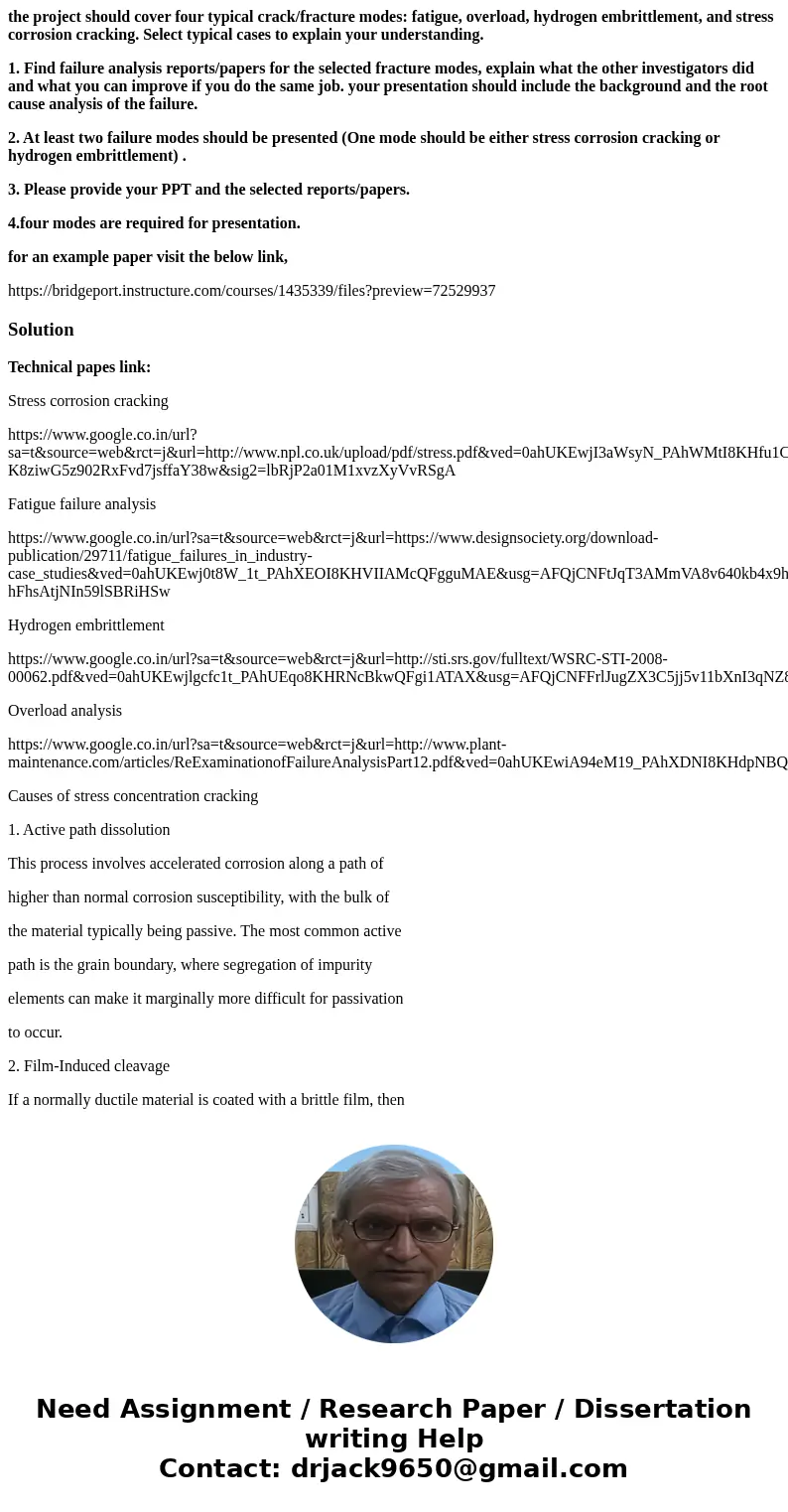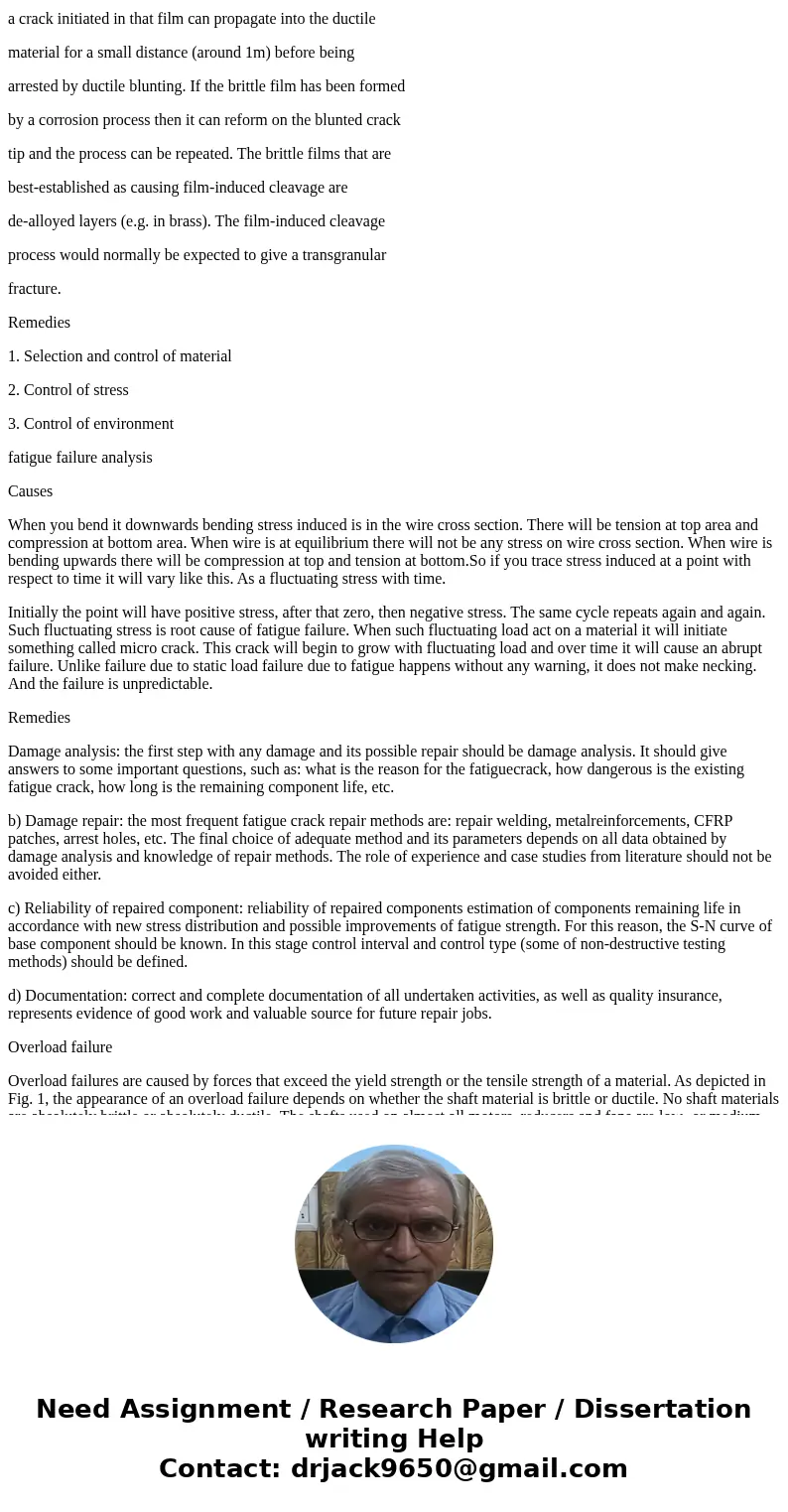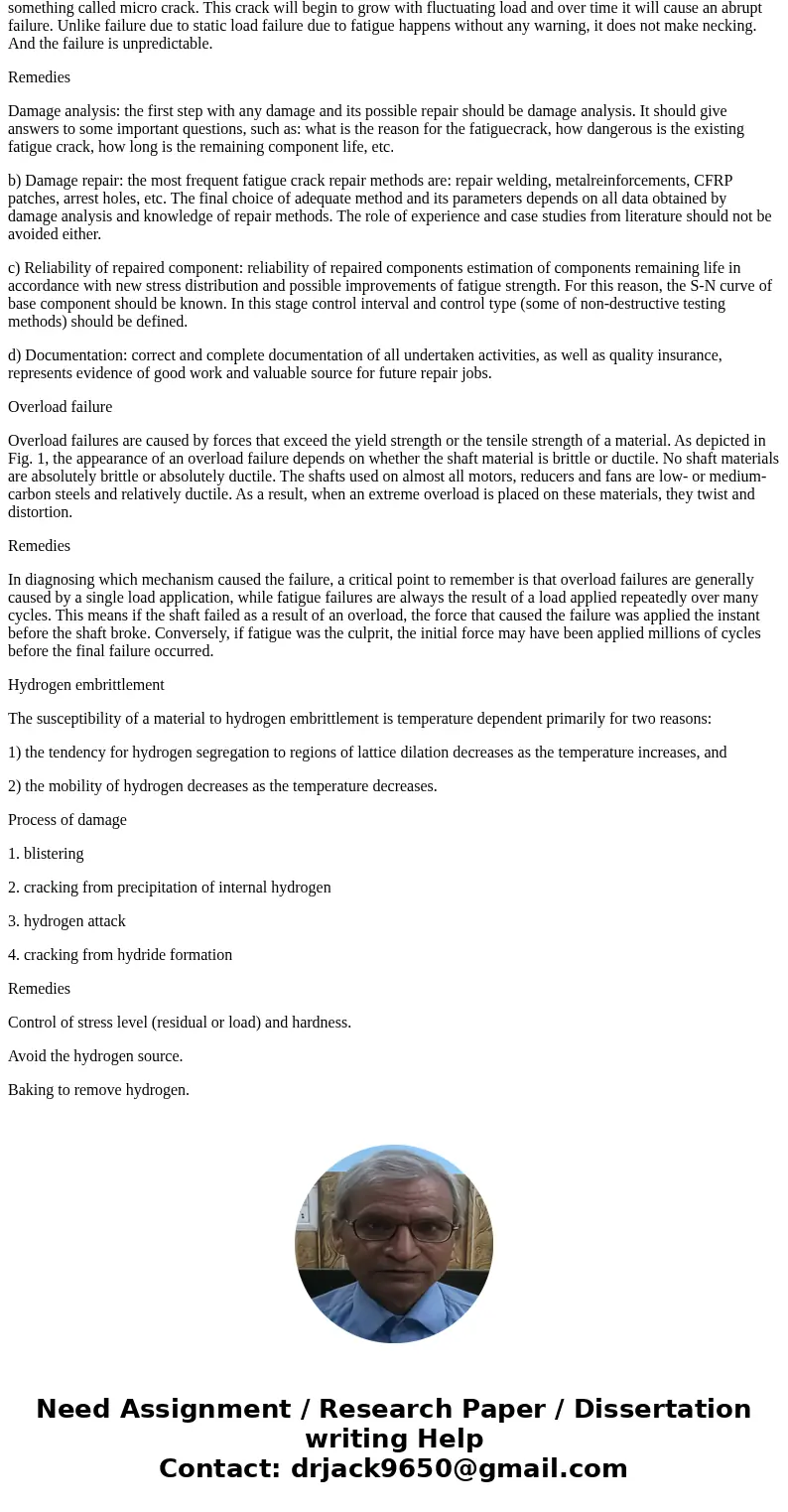the project should cover four typical crackfracture modes fa
the project should cover four typical crack/fracture modes: fatigue, overload, hydrogen embrittlement, and stress corrosion cracking. Select typical cases to explain your understanding.
1. Find failure analysis reports/papers for the selected fracture modes, explain what the other investigators did and what you can improve if you do the same job. your presentation should include the background and the root cause analysis of the failure.
2. At least two failure modes should be presented (One mode should be either stress corrosion cracking or hydrogen embrittlement) .
3. Please provide your PPT and the selected reports/papers.
4.four modes are required for presentation.
for an example paper visit the below link,
https://bridgeport.instructure.com/courses/1435339/files?preview=72529937
Solution
Technical papes link:
Stress corrosion cracking
https://www.google.co.in/url?sa=t&source=web&rct=j&url=http://www.npl.co.uk/upload/pdf/stress.pdf&ved=0ahUKEwjI3aWsyN_PAhWMtI8KHfu1CRkQFgggMAA&usg=AFQjCNE-K8ziwG5z902RxFvd7jsffaY38w&sig2=lbRjP2a01M1xvzXyVvRSgA
Fatigue failure analysis
https://www.google.co.in/url?sa=t&source=web&rct=j&url=https://www.designsociety.org/download-publication/29711/fatigue_failures_in_industry-case_studies&ved=0ahUKEwj0t8W_1t_PAhXEOI8KHVIIAMcQFgguMAE&usg=AFQjCNFtJqT3AMmVA8v640kb4x9hLiMtyg&sig2=s-hFhsAtjNIn59lSBRiHSw
Hydrogen embrittlement
https://www.google.co.in/url?sa=t&source=web&rct=j&url=http://sti.srs.gov/fulltext/WSRC-STI-2008-00062.pdf&ved=0ahUKEwjlgcfc1t_PAhUEqo8KHRNcBkwQFgi1ATAX&usg=AFQjCNFFrlJugZX3C5jj5v11bXnI3qNZ8w&sig2=N64U_Ljxi0oQI3dDfOH5iQ
Overload analysis
https://www.google.co.in/url?sa=t&source=web&rct=j&url=http://www.plant-maintenance.com/articles/ReExaminationofFailureAnalysisPart12.pdf&ved=0ahUKEwiA94eM19_PAhXDNI8KHdpNBQ8QFgg8MAM&usg=AFQjCNF_5aPSHxW5LeUeft7WjaQFiInihA&sig2=2GCi1HLApdD7EP3xzp2SbA
Causes of stress concentration cracking
1. Active path dissolution
This process involves accelerated corrosion along a path of
higher than normal corrosion susceptibility, with the bulk of
the material typically being passive. The most common active
path is the grain boundary, where segregation of impurity
elements can make it marginally more difficult for passivation
to occur.
2. Film-Induced cleavage
If a normally ductile material is coated with a brittle film, then
a crack initiated in that film can propagate into the ductile
material for a small distance (around 1m) before being
arrested by ductile blunting. If the brittle film has been formed
by a corrosion process then it can reform on the blunted crack
tip and the process can be repeated. The brittle films that are
best-established as causing film-induced cleavage are
de-alloyed layers (e.g. in brass). The film-induced cleavage
process would normally be expected to give a transgranular
fracture.
Remedies
1. Selection and control of material
2. Control of stress
3. Control of environment
fatigue failure analysis
Causes
When you bend it downwards bending stress induced is in the wire cross section. There will be tension at top area and compression at bottom area. When wire is at equilibrium there will not be any stress on wire cross section. When wire is bending upwards there will be compression at top and tension at bottom.So if you trace stress induced at a point with respect to time it will vary like this. As a fluctuating stress with time.
Initially the point will have positive stress, after that zero, then negative stress. The same cycle repeats again and again. Such fluctuating stress is root cause of fatigue failure. When such fluctuating load act on a material it will initiate something called micro crack. This crack will begin to grow with fluctuating load and over time it will cause an abrupt failure. Unlike failure due to static load failure due to fatigue happens without any warning, it does not make necking. And the failure is unpredictable.
Remedies
Damage analysis: the first step with any damage and its possible repair should be damage analysis. It should give answers to some important questions, such as: what is the reason for the fatiguecrack, how dangerous is the existing fatigue crack, how long is the remaining component life, etc.
b) Damage repair: the most frequent fatigue crack repair methods are: repair welding, metalreinforcements, CFRP patches, arrest holes, etc. The final choice of adequate method and its parameters depends on all data obtained by damage analysis and knowledge of repair methods. The role of experience and case studies from literature should not be avoided either.
c) Reliability of repaired component: reliability of repaired components estimation of components remaining life in accordance with new stress distribution and possible improvements of fatigue strength. For this reason, the S-N curve of base component should be known. In this stage control interval and control type (some of non-destructive testing methods) should be defined.
d) Documentation: correct and complete documentation of all undertaken activities, as well as quality insurance, represents evidence of good work and valuable source for future repair jobs.
Overload failure
Overload failures are caused by forces that exceed the yield strength or the tensile strength of a material. As depicted in Fig. 1, the appearance of an overload failure depends on whether the shaft material is brittle or ductile. No shaft materials are absolutely brittle or absolutely ductile. The shafts used on almost all motors, reducers and fans are low- or medium-carbon steels and relatively ductile. As a result, when an extreme overload is placed on these materials, they twist and distortion.
Remedies
In diagnosing which mechanism caused the failure, a critical point to remember is that overload failures are generally caused by a single load application, while fatigue failures are always the result of a load applied repeatedly over many cycles. This means if the shaft failed as a result of an overload, the force that caused the failure was applied the instant before the shaft broke. Conversely, if fatigue was the culprit, the initial force may have been applied millions of cycles before the final failure occurred.
Hydrogen embrittlement
The susceptibility of a material to hydrogen embrittlement is temperature dependent primarily for two reasons:
1) the tendency for hydrogen segregation to regions of lattice dilation decreases as the temperature increases, and
2) the mobility of hydrogen decreases as the temperature decreases.
Process of damage
1. blistering
2. cracking from precipitation of internal hydrogen
3. hydrogen attack
4. cracking from hydride formation
Remedies
Control of stress level (residual or load) and hardness.
Avoid the hydrogen source.
Baking to remove hydrogen.



 Homework Sourse
Homework Sourse